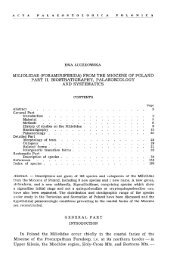The skull of Velociraptor - Acta Palaeontologica Polonica
The skull of Velociraptor - Acta Palaeontologica Polonica
The skull of Velociraptor - Acta Palaeontologica Polonica
Create successful ePaper yourself
Turn your PDF publications into a flip-book with our unique Google optimized e-Paper software.
ACTA PALAEONTOLOGICA POLONICA (44) (2) 211<br />
Angular. - On the labial side, the angular is shallow below the extemal mandibular fenestra, consti-<br />
tuting here less than a quarter <strong>of</strong> the total caudal depth <strong>of</strong> the mandible. It deepens immediately be-<br />
hind the fenestra, narrowing again along its caudal extremity. <strong>The</strong> angular-surangular suture is easily<br />
visible. <strong>The</strong> stout, lateromedially extended splenial process <strong>of</strong> the angular rises rostrodorsally and its<br />
end bears laterally a shallow groove for the tip <strong>of</strong> dentary. On its ventromedial surface this process<br />
has a broad, shallow and relatively long concavity that accommodates the angular process <strong>of</strong> the<br />
splenial. This articular surface is smooth, broader and longer than the respective process <strong>of</strong> the<br />
splenial; its lateral border is somewhat elevated. On the lingual side, the angular is shallow and is ex-<br />
posed below the prearticular. Its rostral portion overlaps the latter bone medially, and more caudally it<br />
underlies the ventral border <strong>of</strong> the prearticular. Mutual relations between the articular surfaces <strong>of</strong> the<br />
splenial and angular might allow some passive rotation <strong>of</strong> the tooth-bearing portion <strong>of</strong> the lower jaw.<br />
Rostrocaudal sliding was probably also possible; flexion <strong>of</strong> the rostral segment <strong>of</strong> the mandible at the<br />
angular-splenial joint does not seem likely, because contact between the two bones seems too long.<br />
Prearticular. - Prearticulars are visible in all V mongoliensis mandibles at our disposal. In ZPAL<br />
MgD-1/97 they are best displayed, but their caudal extremities are broken <strong>of</strong>f. In this latter specimen,<br />
the rostral margin <strong>of</strong> the thin, vertical prearticular blade is deeply embayed along the caudal boundary<br />
<strong>of</strong> the Meckelian fenestra. <strong>The</strong> edge <strong>of</strong> the bone along the embayment is thin, unfinished and might be<br />
continued by an unossified membrane (Barsbold 1983). <strong>The</strong> contact with the angular seems to be<br />
loose rostrally, because, within both mandibular rarni the thin, vertical blade has its ventral margin<br />
slightly displaced laterally, and separated from the dorsomedial edge <strong>of</strong> the angular by a narrow space<br />
filled with sediment. Close to its caudal end, the prearticular curves medially and it seems to be fused<br />
with the articular in GIN 100124 and 25.<br />
Coronoid. - <strong>The</strong> small, triangular coronoid is visible in ZPAL MgD-1/97. It has a sharp dorsal margin<br />
and is sandwiched between the prearticular and a thin plate <strong>of</strong> bone, which may be either a portion <strong>of</strong><br />
the broken dorsal margin <strong>of</strong> the surangular or the caudodorsal end <strong>of</strong> the dentary. <strong>The</strong> rostral comer <strong>of</strong><br />
the coronoid has a narrow long furrow, parallel to the dorsal margin <strong>of</strong> the prearticular.<br />
Surangular. - <strong>The</strong> maximum length <strong>of</strong> the surangular is only somewhat less than that <strong>of</strong> the dentary.<br />
<strong>The</strong> dorsal half <strong>of</strong> the caudal margin <strong>of</strong> the external mandibular fenestra is formed by the surangular. At<br />
the end <strong>of</strong> the mandible, the surangular does not cover its entire labial surface and a narrow portion <strong>of</strong><br />
the prearticular is visible just above the ventral margin. <strong>The</strong> surangular is pierced by a relatively large<br />
surangular foramen. <strong>The</strong> dorsal rim <strong>of</strong> the surangular is inflected medially along the dorsal boundary <strong>of</strong><br />
the adductor fossa. It results in a flat, or even slightly concave broadening <strong>of</strong> the mandibular border.<br />
More rostrally, the dorsal surangular margin becomes sharp. Contact with the dentary along the dorsal<br />
mandibular border is not seen in our specimens. This contact is not visible in the holotype either (Sues<br />
1977a: fig. 2).<br />
Articular. -<strong>The</strong> articular region is either poorly seen or lost in our specimens, but it shows the short<br />
retroarticular process with a concave, weakly caudoventrally inclined dorsal surface. <strong>The</strong> very end <strong>of</strong><br />
the retroarticular process is vertical, lateromedially wide and slightly concave. <strong>The</strong> dorsomedial ver-<br />
tical process seems short and dorsomedially inclined.<br />
<strong>The</strong> exact size <strong>of</strong> the extemal mandibular fenestra is not known in Deinonychus, but<br />
it was probably similarly long. <strong>The</strong> fenestra is much smaller, only about one tenth <strong>of</strong> the<br />
mandibular length, in Dromaeosaurus. <strong>The</strong> resemblance between the lower jaws in<br />
<strong>Velociraptor</strong> and Deinonychus has been noticed by Paul (1988).<strong>The</strong> dentary in these two<br />
genera is less robust than that in Dromaeosaurus. <strong>The</strong> <strong>Velociraptor</strong> dentary differs from<br />
Deinonychus and Dromaeosaurus dentaries in having a convex ventral margin, but the<br />
Saurornitholestes dentary is also weakly convex (Sues 1977b: fig. 1). Splenials in<br />
<strong>Velociraptor</strong>, Deinonychus, Saurornitholestes and Dromaeosaurus are similar in every<br />
respect. <strong>The</strong> caudoventral (= angular process) <strong>of</strong> the splenial is concave along the articu-<br />
lar surface for the angular in all dromaeosaurids, in which it resembles the respective

















